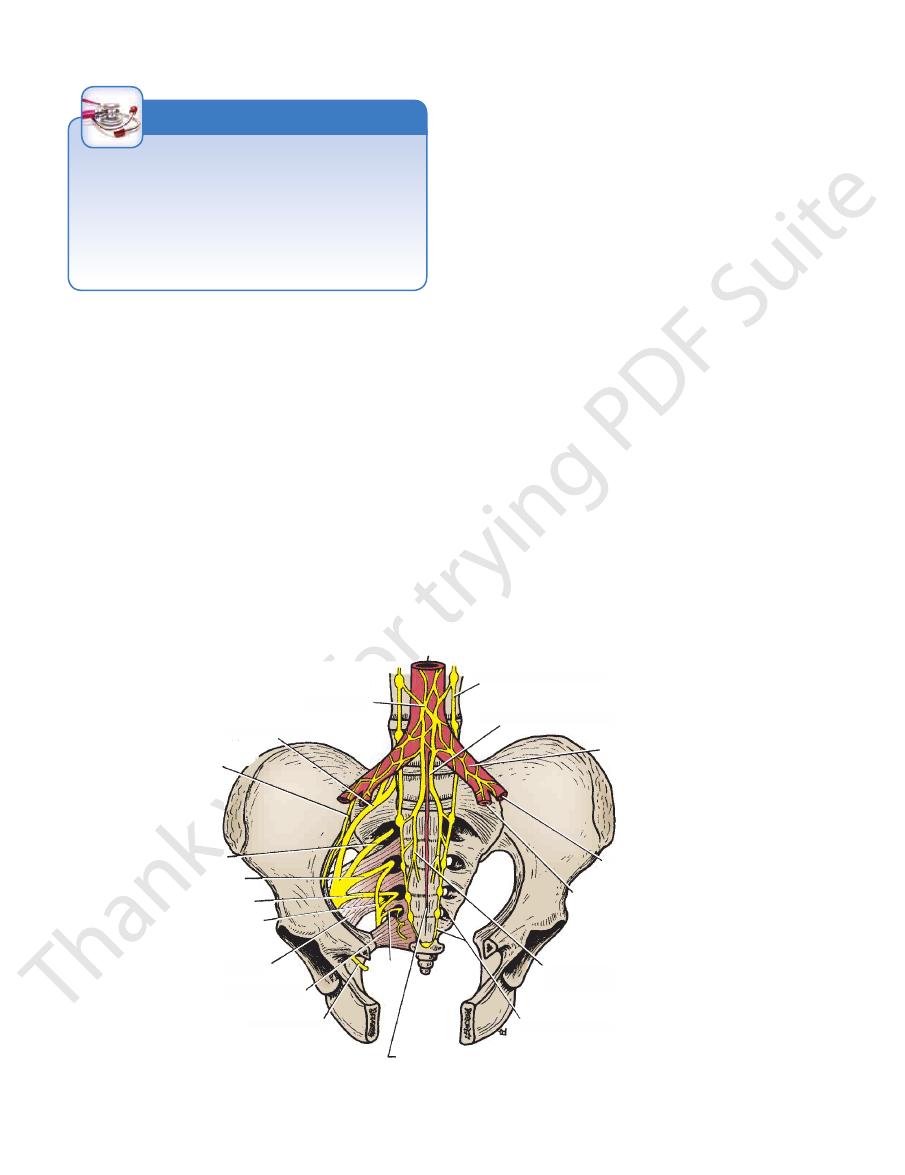
254
CHAPTER 6
The piriformis muscle (Fig. 6.18)
Posteriorly:
and the rectum (Fig. 6.12)
The internal iliac vessels and their branches
Anteriorly:
foramina.
the sacral nerves as they emerge from the anterior sacral
lumbosacral trunk passes down into the pelvis and joins
. The
lumbosacral trunk
fifth lumbar nerve to form the
nerves (Fig. 6.19). The fourth lumbar nerve joins the
anterior rami of the first, second, third, and fourth sacral
anterior rami of the 4th and 5th lumbar nerves and the
of the piriformis muscle (Fig. 6.18). It is formed from the
The sacral plexus lies on the posterior pelvic wall in front
The Pelvis: Part I—The Pelvic Walls
Nerves of the Pelvis
Sacral Plexus
Relations
■
■
■
■
aorta
aortic plexus
lumbosacral trunk
obturator nerve
S1
S2
S3
sacral
plexus
pudendal nerve
piriformis muscle
coccygeus muscle
obturator nerve
median sacral artery
pelvic sympathetic trunk
right and left inferior
hypogastric plexuses
internal iliac artery
external iliac artery
common iliac artery
superior hypogastric plexus
lumbar sympathetic trunk
S4
aortic plexus
umbosacral trunk
nerve
e
e
e
e
S2
S3
l nerve
s muscle
ccygeus muscle
obturator nerve
pelvic sympathetic
right and left
hypogastric p
internal
ex
co
superior hypogastric plexu
lumbar sympathetic trunk
S4
FIGURE 6.18
Posterior pelvic wall showing the sacral plexus, superior hypogastric plexus, and right and left inferior hypogas
the greater sciatic foramen (Fig. 6.12):
Branches to the lower limb that leave the pelvis through
Branches
tric plexuses. Pelvic parts of the sympathetic trunks are also shown.
-
■
■
1.
The
(Fig. 6.9)
branch of the plexus and the largest nerve in the body
(L4 and 5; S1, 2, and 3), the largest
sciatic nerve
2.
The
muscles
teus medius and minimus and the tensor fasciae latae
, which supplies the glu
superior gluteal nerve
-
3.
The
teus maximus muscle
, which supplies the glu
inferior gluteal nerve
-
4.
The
also supplies the inferior gemellus muscle
, which
nerve to the quadratus femoris muscle
5.
The
also supplies the superior gemellus muscle
, which
nerve to the obturator internus muscle
6.
The
perineum:
Branches to the pelvic muscles, pelvic viscera, and
plies the skin of the buttock and the back of the thigh
, which sup
posterior cutaneous nerve of the thigh
-
■
■
1.
The
perineum through the lesser sciatic foramen (Fig. 6.12)
vis through the greater sciatic foramen and enters the
(S2, 3, and 4), which leaves the pel
pudendal nerve
-
2.
The nerves to the piriformis muscle
3.
The
summarized in Table 6.2.
The branches of the sacral plexus and their distribution are
skin of the lower medial part of the buttock
, which supplies the
perforating cutaneous nerve
The
are distributed to the pelvic viscera.
from the second, third, and fourth sacral nerves. They
sacral part of the parasympathetic system and arise
, which constitute the
pelvic splanchnic nerves
■
■
C L I N I C A L N O T E S
Fascial Ligaments of the Uterine Cervix
cervix are of particular clinical importance because they
In the female, the fascial ligaments attached to the uterine
assist with the support of the uterus and thus prevent uter-
ine prolapse (see page 288). The visceral pelvic fascia around
the uterine cervix and vagina is commonly referred to as the
parametrium.

Basic Anatomy
255
posterior cutaneous
nerve of the thigh
L4
L5
S1
S2
S3
S4
S5
C1
lumbosacral trunk
superior gluteal nerve
inferior gluteal nerve
nerve to obturator internus
nerve to quadratus femoris
sciatic nerve
common peroneal nerve
tibial nerve
perforating cutaneous nerve
pudendal nerve
FIGURE 6.19
Sacral plexus.
joint and runs forward on the lateral pelvic wall in the angle
down into the pelvis. It crosses the front of the sacroiliac
in the abdomen, and accompanies the lumbosacral trunk
and 4), emerges from the medial border of the psoas muscle
The obturator nerve is a branch of the lumbar plexus (L2, 3,
Obturator Nerve
iliac joint and joins the sacral plexus.
now enters the pelvis by passing down in front of the sacro
the lumbosacral trunk (Figs. 6.18 and 6.19). This trunk
joins the anterior ramus of the 5th lumbar nerve to form
emerges from the medial border of the psoas muscle and
Part of the anterior ramus of the fourth lumbar nerve
Lumbosacral Trunk
Branches of the Lumbar Plexus
-
between the internal and external iliac vessels (Fig. 6.12).
promontory of the sacrum (Fig. 6.18). It is formed as a
The superior hypogastric plexus is situated in front of the
Superior Hypogastric Plexus
of the anal canal.
the large bowel from the left colic flexure to the upper half
along branches of the inferior mesenteric artery to supply
inferior mesenteric plexus. The fibers are then distributed
hypogastric plexuses and thence via the aortic plexus to the
Some of the parasympathetic fibers ascend through the
plexus or in the walls of the viscera.
nerves and synapse in ganglia in the inferior hypogastric
preganglionic fibers arise from the 2nd, 3rd and 4th sacral
part of the autonomic nervous system in the pelvis. The
The pelvic splanchnic nerves form the parasympathetic
Pelvic Splanchnic Nerves
Fibers that join the hypogastric plexuses
nerves
Gray rami communicantes to the sacral and coccygeal
Branches
finally unite in front of the coccyx.
tally arranged ganglia. Below, the two trunks converge and
foramina. The sympathetic trunk has four or five segmen
on the front of the sacrum, medial to the anterior sacral
inal part (Fig. 6.18). It runs down behind the rectum
above, behind the common iliac vessels, with the abdom
The pelvic part of the sympathetic trunk is continuous
Pelvic Part of the Sympathetic Trunk
lateral wall of the pelvis.
Sensory branches supply the parietal peritoneum on the
Branches
is considered on page 465.
thigh. The distribution of the obturator nerve in the thigh
pass through the canal to enter the adductor region of the
brane), it splits into anterior and posterior divisions that
obturator foramen, which is devoid of the obturator mem
On reaching the obturator canal (i.e., the upper part of the
-
Autonomic Nerves
-
-
■
■
■
■
C L I N I C A L N O T E S
Sacral Plexus
ments of the cord as they emerge from the dura mater. The
endings, leading to referred pain down the inner side of the right
into the pelvic cavity could cause irritation of the obturator nerve
plies the parietal peritoneum. An inflamed appendix hanging down
The discomfort, caused by pressure from the fetal head, is often
comfort or aching pain extending down one of the lower limbs.
During the later stages of pregnancy, when the fetal head has
Pressure from the Fetal Head
descended into the pelvis, the mother often complains of dis-
relieved by changing position, such as lying on the side in bed.
Invasion by Malignant Tumors
The nerves of the sacral plexus can become invaded by malig-
nant tumors extending from neighboring viscera. A carcinoma
of the rectum, for example, can cause severe intractable pain
down the lower limbs.
Referred Pain from the Obturator Nerve
The obturator nerve lies on the lateral wall of the pelvis and sup-
thigh. Inflammation of the ovaries can produce similar symptoms.
Caudal Anesthesia (Analgesia)
Anesthetic solutions can be injected into the sacral canal
through the sacral hiatus. The solutions then act on the spinal
roots of the 2nd, 3rd, 4th and 5th sacral and coccygeal seg-
roots of higher spinal segments can also be blocked by this
method. The needle must be confined to the lower part of the
sacral canal, because the meninges extend down as far as the
lower border of the second sacral vertebra. Caudal anesthe-
sia is used in obstetrics to block pain fibers from the cervix of
the uterus and to anesthetize the perineum.

256
CHAPTER 6
deep circumflex
inferior epigastric
and gives off the
the psoas muscle, following the pelvic brim (Fig. 6.12),
The external iliac artery runs along the medial border of
nal iliac arteries (Figs. 6.12 and 6.18).
the sacroiliac joint by dividing into the external and inter
Each common iliac artery ends at the pelvic inlet in front of
cera via small subsidiary plexuses.
and visceral afferent fibers. Branches pass to the pelvic vis
preganglionic and postganglionic parasympathetic fibers,
nic nerve. It contains postganglionic sympathetic fibers,
superior hypogastric plexus) and from the pelvic splanch
Each plexus is formed from a hypogastric nerve (from the
rectum, the base of the bladder, and the vagina (Fig. 6.18).
The inferior hypogastric plexuses lie on each side of the
Inferior Hypogastric Plexuses
nerves
left hypogastric
and
right
divides inferiorly to form the
ceral afferent nerve fibers. The superior hypogastric plexus
pathetic and sacral parasympathetic nerve fibers and vis
3rd and 4th lumbar sympathetic ganglia. It contains sym
continuation of the aortic plexus and from branches of the
artery to the vas deferens
male; it also gives off the
the bladder and the prostate and seminal vesicles in the
This artery supplies the base of
Inferior vesical artery:
leaves the pelvis through the obturator canal.
lateral wall of the pelvis with the obturator nerve and
This artery runs forward along the
Obturator artery:
supplies the upper portion of the bladder (Fig. 6.12).
, which
superior vesical artery
umbilical artery arises the
From the proximal patent part of the
Umbilical artery:
Branches of the Anterior Division
usual arrangement is shown in Diagram 6.1.
gin of the terminal branches is subject to variation, but the
the perineum, the pelvic walls, and the buttocks. The ori
The branches of these divisions supply the pelvic viscera,
divides into anterior and posterior divisions (Fig. 6.12).
the upper margin of the greater sciatic foramen, where it
The internal iliac artery passes down into the pelvis to
Internal Iliac Artery
Median sacral artery
Ovarian artery
Superior rectal artery
Internal iliac artery
The following arteries enter the pelvic cavity:
Arteries of the True Pelvis
femoral artery
inguinal ligament to become the
branches. It leaves the false pelvis by passing under the
The Pelvis: Part I—The Pelvic Walls
iliac
.
■
■
■
■
■
■
■
■
-
■
■
■
■
■
■
.
-
-
.
-
-
Arteries of the Pelvis
Common Iliac Artery
-
External Iliac Artery
and
half of anal canal, perianal skin, skin of penis, scrotum, clitoris, and labia majora and
Muscles of perineum including the external anal sphincter, mucous membrane of lower
digitorum brevis muscles; skin over cleft between first and second toes. The superficial
extensor hallucis longus, extensor digitorum longus, peroneus tertius, and extensor
Biceps femoris muscle (short head) and via deep peroneal branch: tibialis anterior,
muscles of sole of foot; sural branch supplies skin on lateral side of leg and foot
digitorum longus, flexor hallucis longus, and via medial and lateral plantar branches to
[hamstring part]), gastrocnemius, soleus, plantaris, popliteus, tibialis posterior, flexor
Tibial portion
Skin over posterior surface of thigh and popliteal fossa, also over lower part of buttock,
Branches
Distribution
Superior gluteal nerve
Gluteus medius, gluteus minimus, and tensor fasciae latae muscles
Inferior gluteal nerve
Gluteus maximus muscle
Nerve to piriformis
Piriformis muscle
Nerve to obturator internus
Obturator internus and superior gemellus muscles
Nerve to quadratus femoris
Quadratus femoris and inferior gemellus muscles
Perforating cutaneous nerve
Skin over medial aspect of buttock
Posterior cutaneous nerve of thigh
scrotum, or labium majus
Sciatic nerve (L4, 5; S1, 2, 3)
Hamstring muscles (semitendinous, biceps femoris [long head], adductor magnus
Common peroneal portion
peroneal branch supplies the peroneus longus and brevis muscles and skin over lower
third of anterior surface of leg and dorsum of foot
Pudendal nerve
minora
Branches of the Sacral Plexus and their Distribution
T A B L E 6 . 2

Basic Anatomy
not enter the pelvis.) The ovarian artery arises from
(The testicular artery enters the inguinal canal and does
Ovarian Artery
membrane of the rectum and the upper half of the anal canal.
crosses the common iliac artery. It supplies the mucous
rior mesenteric artery. The name changes as the latter artery
The superior rectal artery is a direct continuation of the infe
Superior Rectal Artery
muscle. It supplies the gluteal region.
through the greater sciatic foramen above the piriformis
This artery leaves the pelvis
Superior gluteal artery:
structures (Fig. 6.12).
of the sacral plexus, giving off branches to neighboring
These arteries descend in front
Lateral sacral arteries:
acus muscles.
inlet posterior to the external iliac vessels, psoas, and ili
This artery ascends across the pelvic
Iliolumbar artery:
Branches of the Posterior Division
vagina and the base of the bladder.
inferior vesical artery present in the male. It supplies the
This artery usually takes the place of the
Vaginal artery:
ine artery gives off a vaginal branch.
where it anastomoses with the ovarian artery. The uter
uterus. It ends by following the uterine tube laterally,
of the broad ligament along the lateral margin of the
reach the uterus. Here, it ascends between the layers
7.28). It passes above the lateral fornix of the vagina to
(see Fig.
crosses the ureter superiorly
of the pelvis and
This artery runs medially on the floor
Uterine artery:
or second and third sacral nerves.
muscle (Fig. 6.12). It passes between the first and second
through the greater sciatic foramen below the piriformis
This artery leaves the pelvis
Inferior gluteal artery:
of the anal canal and the skin and muscles of the perineum.
the pudendal nerve. Its branches supply the musculature
foramen and passes forward in the pudendal canal with
enters the perineum by passing through the lesser sciatic
teal region below the piriformis muscle (Fig. 6.12). It then
through the greater sciatic foramen and enters the glu
This artery leaves the pelvis
Internal pudendal artery:
rior rectal and inferior rectal arteries.
cle of the lower rectum and anastomoses with the supe
the inferior vesical artery (Fig. 6.12). It supplies the mus
Commonly, this artery arises with
Middle rectal artery:
iliac nodes
common
, and
internal iliac nodes
external iliac nodes
are
blood vessels with which they are associated. Thus, there
the main blood vessels. The nodes are named after the
The lymph nodes and vessels are arranged in a chain along
Lymphatics of the Pelvis
artery and end by joining the left common iliac vein.
The median sacral veins accompany the corresponding
Median Sacral Veins
vein (Fig. 6.12).
and joins the external iliac vein to form the common iliac
iliac artery. It passes upward in front of the sacroiliac joint
tributaries that correspond to the branches of the internal
The internal iliac vein begins by the joining together of
Internal Iliac Vein
deep circumflex iliac veins
inferior epigastric
(Fig. 6.12). It receives
common iliac vein
vein to form the
side of the corresponding artery and joins the internal iliac
a continuation of the femoral vein. It runs along the medial
The external iliac vein begins behind the inguinal ligament as
External Iliac Vein
Veins of the Pelvis
Chapter 7.
arteries is discussed in detail with the individual viscera in
The distribution of the visceral branches of the pelvic
anterior surface of the sacrum and coccyx.
bifurcation of the aorta (Fig. 6.18). It descends over the
The median sacral artery is a small artery that arises at the
Median Sacral Artery
way of the mesovarium.
passes into the broad ligament and enters the ovary by
enters the suspensory ligament of the ovary. It then
It crosses the external iliac artery at the pelvic inlet and
passes downward and laterally behind the peritoneum.
lumbar vertebra. The artery is long and slender and
the abdominal part of the aorta at the level of the first
257
the
and
.
,
.
■
■
-
-
■
■
-
■
■
■
■
-
■
■
■
■
-
■
■
■
■
-
Anterior division
Posterior division
Umbilical artery
Obturator artery
Inferior vesical artery
Middle rectal artery
Internal pudendal artery
Inferior gluteal artery
Uterine artery (female)
Vaginal artery (female)
Iliolumbar artery
Lateral sacral artery
Superior gluteal artery
artery to vas deferens (male)
superior vesical artery
DIAGRAM 6.1
Branches of the Internal Iliac Artery
